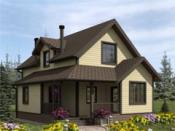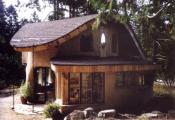Search
Login
Recommended
Ornamental and medicinal plants on the site. Honeysuckle: planting, growing and care
The common name Honeysuckle unites more than 200 species of this plant. A distinctive feature of each of them is the extraordinary beauty of the bush, attracting the close attention of gardeners, amateurs and specialists involved in the creation of original landscape compositions. Honeysuckle is a plant with delicate flowers, winter-hardy and unpretentious, some of its varieties have edible fruits.
Content
- Wildlife habitat video
- Choose a place to land
- How to land
- Choose the right seedlings video
- Plant care
- Pruning video
- Breeding methods
- Pests and diseases
- Healing properties
- Honeysuckle in landscape design
Wildlife Honeysuckle Habitat

The greatest variety of honeysuckle species can be found in Southeast Asia, the northern hemisphere is considered the habitat of the plant. Honeysuckle grows in North America, Asia and Europe, in the temperate zone. It occurs in forests of various types, in deserts, in the mountains. Difficult natural conditions contributed to the emergence of varieties less demanding on soil fertility, light and soil moisture.

Often, the types of honeysuckle growing in different places are very different and even have different names. In appearance, the honeysuckle may be an evergreen or deciduous plant having a tree-like shape, a weaving vine or creeping shrub.
Choose a place to land

Good growth and active flowering will provide honeysuckle planting in a lighted area or slightly shaded. You should know that climbing honeysuckle varieties are preferable to plant in sunny areas, and forest varieties in shaded areas. Honeysuckle is unpretentious to the quality of the soil, but more active growth will be observed in the drained area, with loose soil, not too dry and not representing a closed hollow.
A mixture of soil for planting should consist of: turf, peat or humus and sand. If the soil is moist and heavy, lay a layer of drainage of gravel up to 7 cm thick.
How to plant honeysuckle
The honeysuckle, landing and care of which is carried out correctly, takes root pretty well. It is not recommended to leave a distance between plants shorter than 1.6-2 m. When planting, the roots are carefully straightened, covered with a prepared mixture. The plant should not be planted deeply - the root neck should be at ground level. After planting, the seedling is watered, the soil in the hole is mulched.
Two or three-year-old plants should be planted. The landing hole should have a diameter of 25 cm and the same depth. For larger adult plants, the diameter of the pit should reach half a meter. Plants are planted in the form of hedges or in groups.

Honeysuckle is planted in spring if it belongs to varieties with late vegetation, for example: Tangut, Maaka, small-leaved, alpine. But to plant a blue honeysuckle in spring will not succeed: its flowering begins before the soil thaws.
The optimal planting time for plants with early vegetation is August-October: by mid-summer, the apical buds are already planted, and the shoot growth is complete.
Several plants of different varieties should be planted within the site - remember that honeysuckle refers to cross-pollinated plants, a lone bush will not yield a crop.
Choose the right seedlings

- The best option is to purchase seedlings with a closed root system - the roots in this case do not dry out, they have a high survival rate.
- The height of the rooted cuttings should not be less than 25-30 cm or greater than 1.5 m. Make sure that the variety is suitable for planting in the climatic conditions of your area.
- You should think about whether the varieties growing on your site will be able to pollinate each other - this factor will affect the yield.
- The purchased seedling should have a healthy appearance, the shoots should be even, the leaves should be green, there should be no signs of disease on it.
Plant care
The decorativeness of a plant, its flowering, and the yield of edible varieties depend on how correctly and carefully the gardener relates to caring for honeysuckle.

Watering plants is important. They should be made in dry and hot weather at least 2-3 times per season. The volume of water per bush is from 8 to 10 liters. If the site has heavy clay soil, then cultivation without watering can lead to bitterness of the fruit, even when growing dessert varieties, such as Blue Bird, Cinderella, Gerda. Productivity may decrease significantly.
Responsive plant to fertilizer. If young plants lag behind in growth, then produce foliar top dressing with a solution:
- 1% superphosphate
- 0.1% urea
- 0.5% potassium chloride.
Complex mineral fertilizers are applied in an amount of 20-30 g per square meter. Before flowering, water the plant with a solution of liquid fertilizer Kemira-universal: 20 g of fertilizer per 10 liters of water. In autumn, before digging the soil, up to 200 g of ash per 1 sq.m.
When landing in each hole, it is advisable to make
- 50 g of superphosphate,
- 40 g of potassium salt
- 5 kg of manure. This amount of fertilizer will allow the plant to develop normally for two years.
In the summer, you can sprinkle plants.
The soil near the honeysuckle can be loosened and weed. Also should be mulching trunks circles.
Honeysuckle pruning
It is best to prune plants in the fall or early spring. After a year, you can rejuvenate the bush: for this you will need to remove the old branches, leave only the 5 strongest trunks. After this pruning, honeysuckle quickly begins to produce strong shoots overgrowth.
Sanitary pruning may be required for old bushes older than 7 years. When it removes all branches of the lower tier, dried and broken branches on the whole plant. The upper part of the shoots should not be removed: buds with future flowers are concentrated on them.
Bushes, whose age is more than 15 years, can be trimmed to a height of 0.5 m. Enhanced growth of young shoots will make it possible to fully recover a couple of years after pruning.
Honeysuckle propagation methods
The plant can be propagated by cuttings, seeds, layering.
Cuttings
Honeysuckle cuttings are the easiest and most reliable way to reproduce. They are harvested when the shoots break when bent and do not bend. It is important not to miss the moment when the shoots reach maturity - too stiff shoots take root well, but young plants do not have time to prepare for wintering.
Harvested cuttings in the morning or on a cloudy day. For them, the middle part of the shoot is taken with two pairs of leaves, 7-12 cm long, leaf blades are removed halfway from the upper nodes, completely from the lower ones. Planting cuttings is done immediately, in a mixture of peat and sand (3: 1). Best of all, cuttings will take root in a greenhouse or greenhouse, where the air temperature will be from 20 to 25 degrees, it is important to maintain high humidity of air and soil.

Starting from 10 days after disembarkation, i.e. after the appearance of the roots, the seedlings harden: they slightly reduce the air temperature, ventilate the room, reduce the intensity of irrigation. Seedlings are planted in the ground in spring so that they do not suffer during winter frosts, at the beginning of winter they are covered with spruce branches. Flowering and fruiting of such cuttings may occur already in the third year.
This type of reproduction can be applied to the honeysuckle of Chamisso, black, golden, Tatar, Korolkov, Ruphert, Tangut. Worse will be rooted cuttings of varieties of Alpine, Maak, small-leaved.
Bushes division
It can be used for adults over 5 years old plants. Perform the procedure in early spring or autumn. Dig a bush, secateurs divide roots into 2-3 parts, plant on the prepared place.
Seed propagation
Amateur gardeners and breeders apply the cultivation of honeysuckle seeds. In this case, there is no way to predict exactly what the plant will be, the taste of its fruits and yield. At the same time, the properties of honeysuckle can differ greatly from those possessed by the mother bush.
For planting, seeds from quality, ripe fruits are used. After washing, the extracted seeds of early varieties are dried and sown under a film. After the emergence of seedlings, the film is removed, by autumn, 3-4 pairs of leaves appear on the plants. For the winter they are covered with spruce branches.
In the autumn, the honeysuckle of Korolkov is sown. Autumn seedlings develop rapidly, already in July they dive.
In practice, spring sowing of seeds is often used in light, fertile soil, consisting of river sand, peat and humus. Crates with crops are covered with film or glass until seedlings appear. Active seed germination will be observed after about a month. Such plants are picked the next summer.
Pests of honeysuckle and its disease

Almost all plants grown in culture are susceptible to diseases and suffer from pests, this greatly affects the appearance of the plant and its productivity.
The most formidable enemy of the bush - honeysuckle aphid, the plants affected by it stop in growth, their leaves are curled, covered with spots. It is recommended to spray the affected bushes with infusions of pepper, garlic, tobacco. Effective treatments are Actellic, Confidor, Actara, Elaxar.
Rinkafitoptus, or honeysuckle tick, leads to the appearance of spots on the leaves, turning them brown and twisting, such leaves fall prematurely. As measures for combating ticks, thinning of plantings, their treatment by Actellic, Confidor, and acaricides are used.

Defeat scalemay cause shrub death. To combat it, double treatment with Actellic or Rogor is used, with an interval of two weeks. You can also handle branches affected by the kerosene shield.
Honeysuckle may be attacked leaf-eating insectssuch as: caterpillars of a honeysuckle striped sawfly, rosette leaflet, herbivorous bugs. With the mass appearance of pests, Inta-Vir, Decis, Elaxar are used. Leaf-eating pests do not cause serious damage to the plant, but have a negative effect on its appearance.
Spraying with no chemicals is not carried out until the harvest is complete.
Shrub also often suffers from defeat fungal diseaseswhich manifest as spotted leaf lesions. These are diseases such as powdery mildew, cercosporosis, ramulariosis. For prophylaxis, spraying with a copper-soap solution, Fundozol, Topaz is carried out, bushes can also be pollinated with wood ash or colloidal sulfur.
Some species can also affect honeysuckle. phytoviruses: mosaic-rezuki, mottling. Affected plants are best removed from the site and burned.
The healing properties of honeysuckle

Honeysuckle berries contain vitamins, organic acids, sugars in large quantities. Traditional medicine recommends the use of:
- a decoction of fruits as a capillary-strengthening agent,
- fruit tea in the treatment of hypertension, anemia, stomach diseases, cardiovascular diseases,
- infusion of flowers with inflammation of the bladder,
- juice of fresh berries in the treatment of ulcers and lichen,
- a decoction of silt leaves for gargling with a sore throat,
- baths from a decoction of branches with gout and rheumatism.

Honeysuckle in landscape design
The fruits of some varieties of honeysuckle are edible, while all members of the genus are excellent honey plants.

Due to the very high decorative qualities of the shrub, it is actively used to create a landscape gardening landscape to create decorative hedges, as an undergrowth. Use single-planted bushes and included in the decorative groups. Honeysuckle located by a garden stream or pond looks very picturesque.

Honeysuckle is planted among large stones when creating a rockery, it will perfectly decorate the gazebo, arched ceiling, retaining walls. The main thing is that the location of the objects should be located on a well-lit area.





